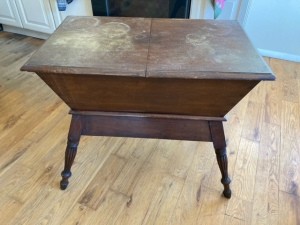 This is a very odd table. The top opens up to a storage area. I believe it's mahogany. I'm interested in any info. maybe age? It's presently out for water damage repair. Plant water seepage damaged the top and my man now has it to restore the lid to its former beauty. If someone knows a value, fine - but I'm not interested in selling.
This is a very odd table. The top opens up to a storage area. I believe it's mahogany. I'm interested in any info. maybe age? It's presently out for water damage repair. Plant water seepage damaged the top and my man now has it to restore the lid to its former beauty. If someone knows a value, fine - but I'm not interested in selling.
Thank you.
Add your voice! Click below to answer. ThriftyFun is powered by your wisdom!
This is Dough Box Table. It is sometimes named Dough Box Side Table www.chairish.com/
These Dough Box Tables originated in Europe, and many were brought to the United States by the Pennsylvania Dutch in the late 1700s. Because of the simplicity of the design, they are known as examples of primitive furniture or country furniture. Most dough boxes seen today in antiques shops were made from 1840 to 1880. They were made by local cabinetmakers or small furniture shops. Homemakers kneaded bread on the flat surface and then placed it in the trough to rise.
As I understand it, you did not find the maker's mark, so it is difficult to determine who and where made this dough box table.
I could not see in your photo how the parts of the table are connected.
The dough box table made in the 18th-early 19th century: www.ebay.com/
and here 1950s dough box table: www.chairish.com/
Please add more photos, especially with the joints (legs, corners).
These were used for kneading bread, and brought over by the Pennsylvania Dutch.
Thank you SO much for this wonderful information. I'm enclosing photos, per your response, perhaps you will use 1-2, but all I think will give info to an experienced eye? There are no nails anywhere, but ONE screw inside the drawer in an odd little "cutout". No obvious reason.. The outside wood is not as deep and rich as the interior which has obviously never seen any sunlight. I suspect this is one of the old ones from the 1800s, and the minor changes, though no doubt which affect the value, are pretty minor all things considered. The drawer is actually undetectable & I had the table for years before I found it when moving.
Thanks again,
Annie In Montana
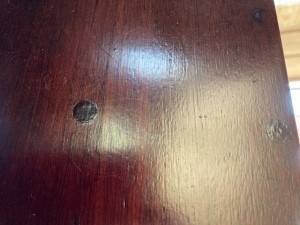
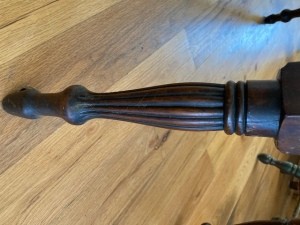

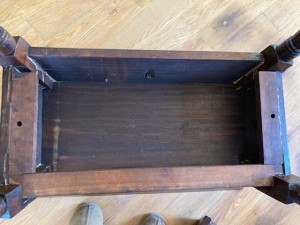
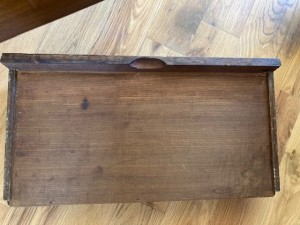
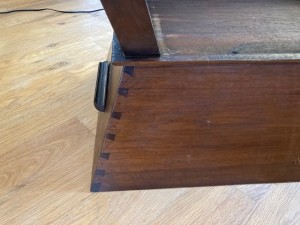
Thank you for photos. If your table had nails, then by the shape of them I would try to determine the approximate period of your dough box table. Since you write that it has no nails, then your dough box table is made of all wood construction with dowels and pegs holding all pieces together.
Your dough box table has dovetail joints. The type of dovetailed joint reveals much about furniture construction and dating. With just a little study, it is easy to spot true hand made construction vs. machine made furniture.
The name "dovetail" comes from the appearance of the joint, resembling the triangle shape of a bird's tail. Dovetail joint was created by a skilled cabinetmaker using small, precision saws and wood chisels. Tiny angled saw cuts were followed by careful cutting by a sharpened chisel on both sides to avoid splintering. One board had tiny "tails", and the other had the larger "pins", carefully measured to match and fit together exactly. A little glue cements the connection, and a good dovetail joint has great strength and durability. Genuine hand made dovetails were the standard of good furniture craftsmanship until about 1870, when American ingenuity developed the "pin and cove" or round style dovetail. These were cut with a jig or pattern. Popular in the U.S. into the 1890's, these joints never gained acceptance outside of the U.S.
From your photo, each "tail" and "pin" of dovetail joints are exactly matched, but the distance between them is not exactly the same. Your dough box has hand-made dovetail joints.
Your dough box table has very beautiful graceful legs. So I think your dough box table was made in the late 18th - early 19th century.
Dear Diana,
Thank you so much for your informative, thoughtful comment on my Dough Box. I will treasure it even more! I plan to keep the information you provided and stow them away in the Dough Box for my daughter.
Thank you again,
Annie
You are welcome :)
Add your voice! Click below to answer. ThriftyFun is powered by your wisdom!